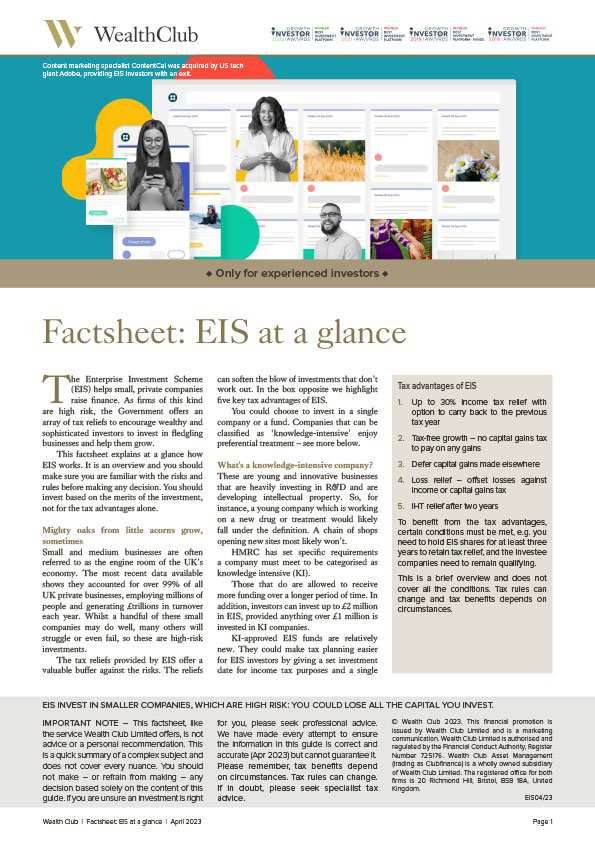Don't invest unless you’re prepared to lose all the money you invest. This is a high-risk investment and you are unlikely to be protected if something goes wrong. Take 2 mins to learn more.
Estimated reading time: 2 min
Due to the potential for losses, the Financial Conduct Authority (FCA) considers this investment to be high risk.
What are the key risks?
- You could lose all the money you invest
- If the business you invest in fails, you are likely to lose 100% of the money you invested. Most start-up businesses fail.
- You are unlikely to be protected if something goes wrong
- Protection from the Financial Services Compensation Scheme (FSCS), in relation to claims against failed regulated firms, does not cover poor investment performance. Try the FSCS investment protection checker here.
- Protection from the Financial Ombudsman Service (FOS) does not cover poor investment performance. If you have a complaint against an FCA-regulated firm, FOS may be able to consider it. Learn more about FOS protection here.
- You won’t get your money back quickly
- Even if the business you invest in is successful, it may take several years to get your money back. You are unlikely to be able to sell your investment early.
- The most likely way to get your money back is if the business is bought by another business or lists its shares on an exchange such as the London Stock Exchange. These events are not common.
- If you are investing in a start-up business, you should not expect to get your money back through dividends. Start-up businesses rarely pay these.
- Don’t put all your eggs in one basket
- Putting all your money into a single business or type of investment for example, is risky. Spreading your money across different investments makes you less dependent on any one to do well.
- A good rule of thumb is not to invest more than 10% of your money in high-risk investments.
- The value of your investment can be reduced
- The percentage of the business that you own will decrease if the business issues more shares. This could mean that the value of your investment reduces, depending on how much the business grows. Most start-up businesses issue multiple rounds of shares.
- These new shares could have additional rights that your shares don’t have, such as the right to receive a fixed dividend, which could further reduce your chances of getting a return on your investment.
If you are interested in learning more about how to protect yourself, visit the FCA’s website here.
The Enterprise Investment Scheme (EIS) was introduced by Chancellor Kenneth Clarke in 1994. Its ambitious aim: to encourage wealthy investors to back the nation’s innovative startups.
30 years on, and now extended for another 10 years, EIS is a powerhouse. It now raises some £2 billion of investment each year onto an average of c.4,000 early-stage British companies. Creating jobs, funding innovation and fuelling the economy in the process.
Investors get generous tax breaks, recognising the high risks of backing young companies. These include: up to 30% income tax relief, tax-free growth, deferral on capital gains made elsewhere, loss relief, and inheritance tax relief (if the investment is held at least two years and on death). Tax rules can change and benefits depend on circumstances.
Important: The information on this website is for experienced investors. It is not advice, research, nor a personal recommendation to invest. The video represents the views of the people interviewed – you should form your own view. If you’re unsure an investment is right for you, please seek advice.
EIS at 30: Why consider investing now?
We’ve asked three well-regarded EIS fund managers – each with a different investment approach – for their insight.
Our roundtable discussion on EIS explores areas including: recent shifts in venture investing, emerging opportunities such as AI (hype or real disruption?) and how to identify good founders.
Why does the success of a business hinge on the quality of its founding team? What are benefits and risks for EIS investors? What kind of returns can investors expect, and in what timeframe? Is now a good time to invest in EIS?
Ed Guinness of Guinness Ventures, Fred Soneya of Haatch and Andy Barrow of Praetura join Wealth Club’s founder Alex Davies at the roundtable.
Watch the video:
Read more and see how to apply online
What tax relief does EIS offer?
Investing in young companies can be rewarding but is also risky. Some of these companies might do very well, but inevitably others will struggle and some will fail.
The tax incentives the government offers under the Enterprise Investment Scheme (EIS) provide a valuable buffer against this risk. They mitigate the impact of investments that don’t work out and amplify the impact of investments that do well.
Below is a brief outline based on current rules: there are detailed conditions and rules you should consider carefully before investing. Decisions should be based on the investment merit, not the tax reliefs alone.
Up to 30% income tax relief
A £100,000 investment could provide a £30,000 saving on your income tax bill for the tax year when your capital is deployed.
To claim the relief, you must have sufficient income tax liability in the first place. You must then hold the shares for at least three years.
You can invest up to £1 million (or potentially up to £2 million if at least £1 million is invested in knowledge-intensive companies – giving you potentially up to £600,000 in income tax relief).
Carry back
Assuming you have the allowance, you could ‘carry back’ – offset the tax relief against the previous year’s tax bill, and potentially get back tax you’ve already paid.
Tax-free growth
You normally pay no Capital Gains Tax (CGT) when realising EIS shares, if you have claimed income tax relief on them and the companies still qualify. This is known as ‘EIS disposal relief’.
Capital gains deferral
If you have realised a taxable gain (e.g. by selling investments or a second home) and invest that gain in an EIS-qualifying investment, you can defer the capital gain for as long as the money stays invested and the EIS conditions are not breached.
You can defer gains of any size, made up to three years before and one year after the EIS investment. You can defer a gain even if you have already paid the tax. Once you get your money out, the gain comes back into charge and you pay CGT at the prevailing rate. Alternatively, you could invest into another EIS and continue to defer the gain.
Inheritance tax relief
Under current rules, an investment in an EIS-qualifying company should benefit from 100% relief from inheritance tax, provided the investment is held for two years and at the time of death.
From 6 April 2026 100% IHT relief on EIS private companies will be limited to the first £1 million of qualifying assets (including private companies and agricultural property), with the remainder eligible for 50% IHT relief (an effective IHT rate of 20%). Any qualifying S/EIS companies quoted on AIM will be eligible for 50% IHT relief (an effective IHT rate of 20%).
Loss relief
If things don’t go to plan, you can choose to offset any loss, less the income tax relief received, against your income tax bill. So, an additional-rate taxpayer could effectively reduce a total loss of £1 to 38.5p. Read more on how EIS loss relief works.
Guides & factsheets
Explore more about EIS
Wealth Club aims to make it easier for experienced investors to find information on – and apply for – investments. You should base your investment decision on the offer documents and ensure you have read and fully understand them before investing. The information on this webpage is a marketing communication. It is not advice or a personal or research recommendation to buy any of the investments mentioned, nor does it include any opinion as to the present or future value or price of these investments. It does not satisfy legal requirements promoting investment research independence and is thus not subject to prohibitions on dealing ahead of its dissemination.



